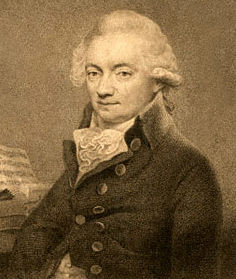Haydn composed Symphony No. 94, also known as the Surprise Symphony, in 1791. Although most of Haydn's 104 symphonies were composed while he was employed by the Esterházy family, some of his later symphonies such as the Surprise Symphony, were not. During the Classical Period, genres (large forms) such as symphonies, string quartets, sonatas and concertos were usually structured in multi-movement plans such as:
Concerto (three movements)
String quartet and trio (three or four movements)
Sonata (for solo instruments or solo instrument with piano accompaniment—three or four movements)
Symphony (four movements)
Haydn's symphonies used a four movement structure, and the inner structure of each of these movements typically used the following standardized small forms:
Typical Symphony Structure—4 movements
1st movement: Fast. Sonata-Allegro design.
2nd movement: Slow. Theme and variations, Sonata-Allegro, Rondo or Through composed design.
3rd movement: A dance form, such as Minuet and Trio or Scherzo (usually in triple meter).
4th movement: Fast. Rondo or Sonata-Allegro design

The last twelve symphonies that Haydn wrote are often called the London Symphonies; twelve symphonies that were commissioned by Johann Peter Salomon, a London violinist and concert producer. Salomon not only paid for Haydn to write the music, but he also arranged for Haydn to come to London to conduct them. It is interesting to note that the number of players in Classical period orchestras expanded during Haydn's lifetime. The size of Haydn's Esterházy orchestra was 13-24 players, a typical size for a Classical period orchestra, and probably more comparable to what would be called a chamber orchestra today. Towards the end of his career, when Haydn conducted some of his late symphonies in London, the size of orchestras playing his music had increased to 60.
Haydn composed Symphony No. 94 in 1791, and the first performance was held in London in 1792 at one of Salomon's subscription concerts. It is nicknamed the Surprise Symphony because of a surprising, loud and unexpected chord in the second movement, "Andante" (this chord occurs immediately after a very quiet, pianissimo section) [7]. Haydn described why he inserted this loud chord in the second movement of his Symphony No. 94:
I asked him once in jest whether it was true that he had composed the Andante with the Drum Stroke [Symphony No. 94] to waken the English who fell asleep at his concert. 'No,' came the answer, 'but I was interested in surprising the public with something new; and in making a brilliant debut, so that my student Pleyel, who was at that time engaged by an orchestra in London (in 1792) and whose concerts had opened a week before mine, should not outdo me. [8]
TECHNIQUE TIPS: The second movement of Haydn's Surprise Symphony uses the musical form of a theme and variations and is well known for its sudden fortissimo (very loud) chord at the end of a very quiet (pianissimo) This arrangement begins with the tempo marking andante, indicating a moderately slow tempo should be used. First and second endings are also found in this movement, and these endings indicate the performer should play the first ending the first time through the music, and then return to the beginning of the piece. When playing through the music for a second time, the first ending should be skipped over, and the second ending should be played. This movement begins softly, with the dynamic marking of p (play softly or quietly). Another dynamic marking is found at the beginning of the piece: pp, and it is placed in parentheses next to the p, piano marking. This pp in parentheses, indicates when the music is played through the second time, it should be played pianissimo (pp), meaning very softly. Haydn used this second pp dynamic marking to heighten the "surprise" of the note in measure 9 which has the dynamic marking fortissimo ff, which means the note should be played very loud. An accent is also placed over the note in measure 9, indicated by the sign >, and this means the note should be played forcefully. Dots are also placed over some of the notes in this piece, indicating a light, crisp, slightly separated bow stroke should be used (you may want to experiment with the bowing for these sections, and decide for yourself if you want to use an on-the-string stroke such as martelé or staccato, or an off-the-string bow stroke such as spiccato). Beginning in measure 10, a new theme with a melody featuring slurs is presented, and a variation of the main theme returns in measure 18 to the end.
© Copyright 2025 RK Deverich. All rights reserved.
Although this online violin class is provided free of charge, all rights are reserved and this content is protected by international copyright law. It is illegal to copy, post or publish this content in any form, and displaying any of this material on other websites, blogs or feeds is prohibited. Permission is given for individual users to print pages and perform music from this website for their personal, noncommercial use.